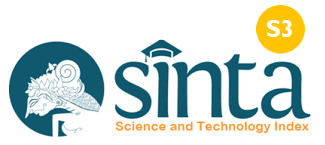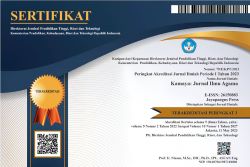Penerapan Model ARCS (Attention, Relevance, Confidance, Satisfaction) Pada Mata Pelajaran PAI Untuk Meningkatkan Motivasi Belajar Siswa Kelas XI 7 Di SMAN 1 Palangka Raya
DOI:
https://doi.org/10.37329/kamaya.v8i2.4124Keywords:
ARCS (Attention, Relevance, Confidance, Satisfaction) Model, Student Learning MotivationAbstract
The learning model in Islamic Religious Education for class XI 7 at SMAN 1 Palangka Raya is less effective due to the boring lecture method, resulting in low student participation and learning outcomes. This research aims to determine the motivation for learning Islamic Religious Education (PAI) and analyze the application of the ARCS model (Attention, Relevance, Confidence, Satisfaction) in PAI learning at SMAN 1 Palangka Raya through the Classroom Action Research (CAR) method, which is conducted in two cycles that include the stages of planning, implementation, observation, and reflection. The subjects in this study were 31 students from class XI 7 at SMA Negeri 1 Palangka Raya, consisting of 11 male students and 20 female students. The research results show that the ARCS model effectively increases students' motivation and academic achievement. Teacher activity increased from 80% in cycle I to 93% in cycle II, while student activity rose from 76% to 93%. Learning motivation also increased on all indicators, such as enjoyment, interest, activity, and enthusiasm for learning. In conclusion, the ARCS model is effective in enhancing student motivation and engagement in PAI learning. Meanwhile, the distribution of the questionnaire on the aspects of enjoyment and interest increased from an average of 89% to 90%, interest and attention increased from an average of 80% to 86%, and activity and motivation to achieve increased from an average of 78% to 85%. The enthusiasm for learning increased from an average of 67% to 88%, and the desire to understand rose from 57% to 83%.
References
Aziz, A., Rachman, P., Muali, C., Baharun, H., Wahyudi, D., Afandi, M., Islam, M. S., & Bon, A. T. (2021). Learning Strategies And Motivation With The Arcs Model For Mobile-Assisted Seamless. Proceedings of the 11th Annual International Conference on Industrial Engineering and Operations Management Singapore, 7-11.
Azizah, A. (2021). Pentingnya Penelitian Tindakan Kelas Bagi Guru Dalam Pembelajaran. Auladuna: Jurnal Prodi Pendidikan Guru Madrasah Ibtidaiyah, 3(1), 15-22.
Barokati, N., Wangi, N. B. S., & Wajdi, M. B. N. (2022). Gamification Learning Model to Improve Conceptual Understanding of Aqidah Akhlak Subject. Al-Hayat: Journal of Islamic Education, 6(2), 560-571.
Batula, A. W., Faqihuddin, A., Munandar, H., Indonesia, U. P., Barat, J., & City, N. (2024). Analysis Use Motivation Study Student in Islamic Religious Education Learning Using the PAKEM Method in Senior High Schools. Medina-Te: Jurnal Studi Islam, 20(2), 152-166.
Fernando, Y., Andriani, P., & Syam, H. (2024). Pentingnya Motivasi Belajar Dalam Meningkatkan Hasil Belajar Siswa. ALFIHRIS: Jurnal Inspirasi Pendidikan, 2(3), 61-68.
Festiawan, R. (2020). Belajar Dan Pendekatan Pembelajaran. Universitas Jenderal Soedirman, 11, 1-17.
Harahap, N. F., Anjani, D., & Sabrina, N. (2021). Article Analysis of Motivation Methods and Student Learning Motivation Functions. Indonesian Journal Of Intellectual Publication, 1(3), 198-203.
Jamil, M. M. (2019). Optimalisasi Model ARCS Dalam Pembelajaran Saintifik Untuk Meningkatkan Motivasi Belajar Peserta Didik Pada Peminatan Mata Pelajaran Geografi Di Kelas Matematika Ilmu Alam. IJIS Edu: Indonesian Journal of Integrated Science Education, 1(1), 7-24.
Judrah, M., Arjum, A., Haeruddin, H., & Mustabsyirah, M. (2024). Peran Guru Pendidikan Agama Islam Dalam Membangun Karakter Peserta Didik Upaya Penguatan Moral. Journal of Instructional and Development Researches, 4(1), 25-37.
Malisi, M. A. S., Fauziyah, F., & Surawan, S. (2023). Internalization of Faith Educational Value in the Humanistic Perspective Riko Animation Series. Al-Ishlah: Jurnal Pendidikan, 15(1), 703-718.
Maiti, M., & Priyaadharshini, M. (2023). Design And Evaluation Of A Revised ARCS Motivational Model For Online Classes In Higher Education. Heliyon, 9(12).
Malisi, M. A. S., & Sulasman, S., & Mohad, A. H. (2024). Institutionalizing Educational Reform: Balancing Tradition And Modernity At Pesantren. Jurnal Pendidikan Islam, 10(2), 363-374.
Nanggala, A. (2020). Analisis Wacana Pembaharuan Kebijakan Zonasi Menteri Pendidikan Dan Kebudayaan Nadiem Makarim Sebagai Solusi Pemerataan Pendidikan Di Indonesia. Jurnal Pendidikan Kewarganegaraan Undiksha, 8(2), 46-56.
Pristiwanti, D., Badriah, B., Hidayat, S., Dewi, R. S. (2022). Pengertian Pendidikan. Jurnal Bioedukasi, 4(6), 7911-7915.
Rizkita, K., & Supriyanto, A. (2020). Komparasi Kepemimpinan Pendidikan Di Indonesia Dan Malaysia Dalam Upaya Peningkatan Mutu Pendidikan. Jurnal Akuntabilitas Manajemen Pendidikan, 8(2), 155-164.
Romlah, S., & Rusdi, R. (2023). Pendidikan Agama Islam Sebagai Pilar Pembentukan Moral Dan Etika. Al-Ibrah: Jurnal Pendidikan dan Keilmuan Islam, 8(1), 67-85.
Sari, A. W., & Rahmi, A. (2023). Perancangan Bahan Ajar Interaktif Berbasis Arcs (Attention, Relevance, Confidence, And Satisfaction) Untuk Meningkatkan Motivasi Belajar Siswa di SMP 31 Padang. INTEGRATIF: Jurnal Pengabdian Kepada Masyarakat, 1(1), 1-7.
Setiawan, D., Kabibullah, N., & Wadi, I. S. (2020). Penerapan Model Arcs (Attention, Relevance, Confidence, Satisfaction) Dalam Proses Pembelajaran Pendidikan Agama Islam (PAI) di SMK Muara Ilmu Depokâ€. Mozaic: Islam Nusantara, 6(1), 61-78.
Simamora, L., Hernaeny, U., & Safitri, N. D. (2020). Pengaruh Model Pembelajaran Attention, Relevance, Confidence, Satisfaction (ARCS) terhadap Kemampuan Pemecahan Masalah Matematika. JKPM (Jurnal Kajian Pendidikan Matematika), 5(2), 245-252.
Sipahutar, N., Wandini, R. R., & Suheri, M. (2023). Peran Pendidikan Agama Islam dalam Membangun Moralitas Siswa di Era Digital (Studi di SMP IT Mutiara Aulia Sei Mencirim). Indo-MathEdu Intellectuals Journal, 4(3), 2936-2941.
Sukarno, S., & Salamah, S. (2019). Pengaruh Model Pembelajaran ARCS (Attention, Relevance, Confidence, Satisfaction.) dan Motivasi Terhadap Hasil Belajar IPS Siswa Kelas V SD Negeri 75 Kota Bengkulu. At-Ta'lim: Media Informasi Pendidikan Islam, 18(1), 137-156.
Song, C., & Kao, Q. (2023). Enhancing Learner Motivation By Adapting Strategies From The ARCS Model: Experience From Chinese Online Course Design And Teaching. Journal of China Computer-Assisted Language Learning, 3(1), 168-187.
Wibowo, L. A., & Pardede, L. R. (2019). Peran Guru dalam Menggunakan Model Pembelajaran Collaborative Learning Terhadap Keaktifan Siswa Dalam Belajar. Diskusi Panel Nasional Pendidikan Matematika, 5(1), 201-208.
Wulan, D. K. (2021). Penerapan Model Pembelajaran Arcs (Attention, Relevance, Confidance, Satisfaction) Untuk Meningkatkan Motivasi Belajar Dan Kemampuan Kognitif Siswa Pada Materi Hukum Newton Kelas X SMA. Jurnal Sains Edukatika Indonesia (JSEI), 3(2).
Yuhasnil, Y., & Angggreni, S. (2020). Manajemen Kurikulum Dalam Upaya Peningkatan Mutu Pendidikan. Journal Of Administration and Educational Management (ALIGNMENT), 3(2), 214-221.
Yulianti, Y., Murdani, E., & Kusumawati, I. (2019). Pengaruh Penerapan Model Pembelajaran Attention, Relevance, Confidence, Satisfaction (ARCS) Terhadap Motivasi Belajar dan Hasil Belajar Siswa pada Materi Kalor di Kelas X. Variabel, 2(1), 24-30.
Yulianto, D., Juniawan, E. A., Junaedi, Y., Anwar, S., & Umami, M. R. (2024). Fostering Mathematical Motivation with Wordwall Media: A Study of the ARCS Model (Attention, Relevance, Confidence, and Satisfaction) Based on Sex Among High School Students. SJME (Supremum Journal of Mathematics Education), 8(2), 173-196.
Downloads
Published
How to Cite
Issue
Section
License
Copyright (c) 2025 Kamaya: Jurnal Ilmu Agama

This work is licensed under a Creative Commons Attribution-ShareAlike 4.0 International License.
An author who publishes in the Kamaya : Jurnal Ilmu Agama agrees to the following terms:
- Author retains the copyright and grants the journal the right of first publication of the work simultaneously licensed under the Creative Commons Attribution-ShareAlike 4.0 License that allows others to share the work with an acknowledgement of the work's authorship and initial publication in this journal
- Author is able to enter into separate, additional contractual arrangements for the non-exclusive distribution of the journal's published version of the work (e.g., post it to an institutional repository or publish it in a book) with the acknowledgement of its initial publication in this journal.
- Author is permitted and encouraged to post his/her work online (e.g., in institutional repositories or on their website) prior to and during the submission process, as it can lead to productive exchanges, as well as earlier and greater citation of the published work (See The Effect of Open Access).
Read more about the Creative Commons Attribution-ShareAlike 4.0 Licence here: https://creativecommons.org/licenses/by-sa/4.0/.





